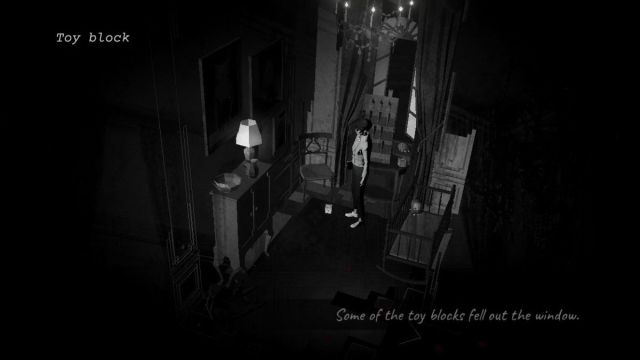There are two things that Lorelei and the Laser Eyes brings to the table that I think make it a puzzle game worth anyone’s time. First, its stunning visuals are reminiscent of the most stylish games ever made, like Killer7. Second, its puzzles grip you and will have you working, inside and out of the game, to solve them.
Lorelei and the Laser Eyes‘ story revolves around the Hotel Letztes Jahr. The protagonist arrives there after receiving an invitation, and that’s all the information you’re given. From this incredibly vague start, you must figure out why you’re here by solving contextual puzzles that allow you to explore more and more of the hotel, while an overarching story eerily seeps out of the walls to fill in the gaps.

Lorelei and the Laser Eyes (Switch [Reviewed], PC)
Developer: Simogo
Publisher: Annapurna Interactive
Released: May 16, 2024
MSRP: $24.99/£19.99
I didn’t click with Lorelei and the Laser Eyes from the start. It took me a few hours to understand what was required of me, and then, after entering a twisted maze, I suddenly got it. I say this because I don’t think this game is for everyone in the same way as I’d say Animal Well is. It’s deliberately obtuse, requires a lot of input, and has clues that you could completely miss for hours at a time.
However, if you’re looking for a puzzle game that will have you scribbling in notebooks and has a slow-burn story you won’t fully understand until the end, this is it.

As you’ve probably worked out by now, the bulk of Lorelei and the Laser Eyes is puzzle-solving. In fact, your very first action, opening the front gate, is a puzzle. You’re always given a clue and directed to the information you need in red. This is why the game’s visuals are so impactful, because everything else is monochrome, giving you an almost supernatural ability to pick out clues where they appear.
It’s this style choice that I think enables Lorelei and the Laser Eyes to be a great puzzle box game. It would be too overwhelming if the environments were richly detailed with colors. But the monochrome color scheme and quiet, almost non-existent soundtrack help you focus in and identify solutions. As someone for which colors on a page can make a book illegible, the visual style helped me grasp the game. But I still struggled at the start.
Back to that front gate. Once you receive your clue, it’s not a simple case of using it to unlock the gate. Instead, there are puzzles within this puzzle. You’ll need to decipher the clue from a letter, use it to unlock a door, then a panel, and then, you’ll need to solve one final puzzle that opens the gate for you.
This felt maddening when I was first getting to grips with the game. It’s as if you’re given a clue for one puzzle and then sent off to do another one until you forget about the first and get lost. That’s not the case, though. Lorelei and the Laser Eyes is designed so that every story beat and revelation plays into a new sequence of puzzles within puzzles.

As you approach the hotel, you’ll feel like you’ve got a handle on these early puzzles and can manage to get inside and explore. But that’s when the game really opens up, dishing out lots of information that won’t make sense until much later. If you’re paying attention, you might even see where some of the puzzles are going early on and have half a chance of getting through two or three before you get stuck again.
Eventually, as I mentioned, everything clicks. You realize how the game frontloads information so you can refer back to it later to solve the dozens of puzzles it throws your way. A collection of images and letters gives you the basic information you need for certain codes and pathways, but you’ll often need to manipulate the information to get your answers.
For example, those images might have numbers you need to add together or type out in a specific order based on environmental cues. Letters and documents provide codes, but they’re wrapped up in further history or discoverable information, like a Russian nesting doll of clues.
Your notebook will come in handy because there’s information you need to reference while looking at objects in some puzzles. Some even had me looking up real-world information for solutions. It preys on your real-world knowledge in subtle ways like this, and it feels fantastic because it adds to the undertone of dread and cosmic horror that slowly rises as you open more doors and uncover more of the truth.

This all sounds like a lot, and it can be, but Lorelei and the Laser Eyes has beautifully simple controls and great systems that make solving its complex puzzles so much more enjoyable. Your protagonist has a photographic memory, so you can reference any document you’ve seen anywhere you need to. It’s simple to explain, and negates any unnecessary complications other games might throw at you to pad out their playtime.
Aside from movement, all you can do is interact with objects or open the menu. The menu allows you to access items you’ve picked up and that photographic memory. Otherwise, you’ll be interacting with keypads, pictures, and everything else possible in the game. I can’t overstate enough how simple this is, and yet its simplicity still feels complicated because of the puzzles you’re solving and the information you’re referencing. All the gymnastics are in your head, though, because you’ve got to hold numbers, sums, images, and the hotel’s layout in your mind to the point where it becomes mentally exhausting.
It feels a lot like playing an ARG or one of the Exit board games. You’ve got so much information to go through and pull together for a puzzle, but Lorelei and the Laser Eyes is more simplistic because of its wonderfully simple UI, controls, and focus on a story you’re led through by listening and watching, not by being told by a tutorial.
That might seem crazy, and it feels crazy while you’re playing. But, like I said, at some point, it just clicks. You no longer see a letter and red lines. You see the start of a puzzle and the basis for solving it. You start to enjoy them and look for more information in every room. That’s when Lorelei and the Laser Eyes decides to genre jump a little.

Without spoiling these changes too much, the game is pocketed with puzzles that are almost minigames that change your perspective, the genre, and even the tone. They feel fun and free compared to the base game’s almost horror-like darkness in the hotel, and help keep up the pace when you might be flagging.
Flashing lights warning: If you’re sold on Lorelei and the Laser Eyes, then you should absolutely go and play it. I want to warn all potential players that flashlight lights begin to take over the screen at some point in the story. They’re not regular, but they are persistent, and there’s no way to turn them off in the settings. If that sounds like it could be an issue for you, it might be worth avoiding the game.
The twisted maze, where I fell in love with Lorelei and the Laser Eyes, is just one great example of these minigames. You’re told to reach the middle, but it’s never quite so simple in a puzzle game like this. Even when I gave up, the game threw yet another puzzle at me linked to my actions in the maze, and that’s when I really understood the game’s flow and where I fit into its world.

Lorelei and the Laser Eyes is an intense puzzle box game that draws you in deeper the more of its mysteries you unravel. Yes, it can be frustrating, but the satisfaction you feel for completing each puzzle is heightened because it asks so much more of you as a player. The story that seems unimportant at first quickly becomes an engrossing and stylistic mystery thriller that will keep you guessing until the end, staying up for just one more hour in the hopes of seeing the next twist or big reveal.
[This review is based on a review build of the game provided by the publisher.]





Published: May 16, 2024 04:00 pm